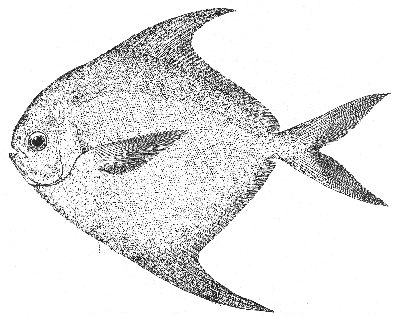Harvestfish Peprilus alepidotus (Linnaeus) 1766
STARFISH
[Jordan and Evermann, 1896-1900, p. 996, as Rhombus paru (Linnaeus) in part.]
Description—
The body of the harvestfish (not including the caudal peduncle) is almost as deep as it is long, and ovate in outline; its nose is rounded, mouth very small, and head very short. The outlines of its dorsal and anal fins afford the readiest field mark to separate it from its relative, the butterfish; both of these being very high and falcate in front, and continuing nearly straight, thence rearward (compare fig. 194 with fig. 192). The mucous pores, conspicuous in the butterfish, are lacking in the harvestfish. There is also a color difference between the two, the harvestfish being greenish silvery above, silvery sometimes tinged with yellow on its sides and belly, while the fins of some specimens are slightly dusky or yellowish. In all other respects (including size) it closely resembles the butterfish.
General range—
From Florida northward along the middle Atlantic Coast of North America; rarely straying north to Cape Cod, Mass., and to Cape Elizabeth, Maine; represented by a close ally (Peprilus paru Linnaeus 1758) in West Indian-Brazilian waters.[30]
Occurrence in the Gulf of Maine—
This fish, although abundant to the southward, rarely strays as far north as the outer Cape Cod coast. A specimen taken at Monomoy Point by Dr. W. C. Kendall in 1896; 5 or 6 caught in floating traps at Richmond Island, off Cape Elizabeth, Maine, in July 1929;[31] one from the Damariscotta River, Maine, in August 1933;[32] and one taken at Race Point at the tip of Cape Cod, in October 1949,[33] are the only Gulf of Maine records of which we know.
